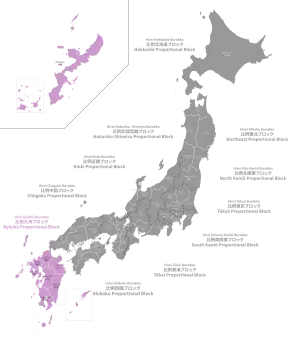| Kyushu Proportional Representation Block | |
|---|---|
| Parliamentary constituency for the Japanese House of Representatives | |
 Map of House of Representatives proportional blocks, with the Kyūshū block highlighted | |
| Prefectures | Fukuoka, Saga, Nagasaki, Kumamoto, Ōita, Miyazaki, Kagoshima, and Okinawa |
| Population | 14,257,000 (October 2019 estimate)[1] |
| Electorate | 11,905,965[2] |
| Current constituency | |
| Representatives | 20 (LDP-7, CDP-3, Hope-4, Komeito-3,JCP-1, SDP-1, Nippon Ishin no Kai-1)[3] |
The Kyushu proportional representation block (九州比例ブロック, Kyūshū hirei burokku) is one of eleven proportional representation (PR) blocks for the House of Representatives in the Diet of Japan.[4][5] It consists of the Kyushu region and Okinawa prefecture (which includes Okinawa island and the Ryukyu Islands), and consists of the prefectures of Fukuoka, Saga, Nagasaki, Kumamoto, Ōita, Miyazaki, Kagoshima, and Okinawa.[6][7] Proportional voting blocks were first introduced in the 1996 General Election.[8] The block elects 21 members to the House of Representatives.
References
- ↑ "Population by Sex for Prefectures - Total population, Japanese population, October 1, Each Year". e-stat.go.jp. Government of Japan. Retrieved 5 August 2021.
- ↑ "Number of registered electoral rolls and overseas electoral rolls for each constituency, etc". soumu.go.jp. Ministry of Internal Affairs and Communications of Japan. Retrieved 5 August 2021.
- ↑ "Results of the 2017 Japanese General Election". Daily Yomiuri. Yomiuri Shimbun. 19 August 2020. Retrieved 5 August 2021.
- ↑ "Changes to Voting Age? 20 or 18?". www.ny.us.emb-japan.go.jp. Retrieved 2021-08-05.
- ↑ Berman, Daniel (2010-07-21). "In Recent Japanese Elections An Unequal Electoral System Explains the Government's Defeat". FiveThirtyEight. Retrieved 2021-08-05.
- ↑ "Kyushu | Facts, History, & Points of Interest". Encyclopedia Britannica. Retrieved 2021-08-06.
- ↑ "Ryukyu Islands | archipelago, Japan". Encyclopedia Britannica. Retrieved 2021-08-06.
- ↑ Christensen, Raymond V. (1994). "Electoral Reform in Japan: How It was Enacted and Changes It May Bring". Asian Survey. 34 (7): 589–605. doi:10.2307/2645370. ISSN 0004-4687. JSTOR 2645370. Retrieved 6 August 2021 – via JSTOR.
This article is issued from Wikipedia. The text is licensed under Creative Commons - Attribution - Sharealike. Additional terms may apply for the media files.